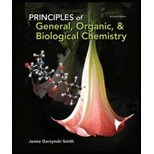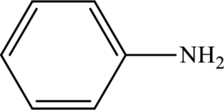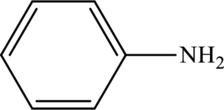
Principles of General Organic & Biological Chemistry
2nd Edition
ISBN: 9780077633721
Author: Janice Smith
Publisher: Mcgraw-hill Higher Education (us)
expand_more
expand_more
format_list_bulleted
Question
Chapter 13, Problem 13.86AP
a.
Interpretation Introduction
Interpretation:
Product formed has to be drawn when the amine given is treated with

Concept Introduction:
b.
Interpretation Introduction
Interpretation:
Product formed has to be drawn when the amine given is treated with

Concept Introduction:
Refer part “a.”.
Expert Solution & Answer
Want to see the full answer?
Check out a sample textbook solution
Students have asked these similar questions
Lab Data
The distance entered is out of the expected range.
Check your calculations and conversion factors.
Verify your distance. Will the gas cloud be closer to the cotton ball with HCI or NH3?
Did you report your data to the correct number of significant figures?
- X
Experimental Set-up
HCI-NH3
NH3-HCI
Longer Tube
Time elapsed (min)
5 (exact)
5 (exact)
Distance between cotton balls (cm)
24.30
24.40
Distance to cloud (cm)
9.70
14.16
Distance traveled by HCI (cm)
9.70
9.80
Distance traveled by NH3 (cm)
14.60
14.50
Diffusion rate of HCI (cm/hr)
116
118
Diffusion rate of NH3 (cm/hr)
175.2
175.2
How to measure distance and calculate rate
For the titration of a divalent metal ion (M2+) with EDTA, the stoichiometry of the reaction is typically:
1:1 (one mole of EDTA per mole of metal ion)
2:1 (two moles of EDTA per mole of metal ion)
1:2 (one mole of EDTA per two moles of metal ion)
None of the above
Please help me solve this reaction.
Chapter 13 Solutions
Principles of General Organic & Biological Chemistry
Ch. 13.1 - Draw out each compound to clearly show what groups...Ch. 13.1 - Prob. 13.2PCh. 13.2 - Prob. 13.3PCh. 13.2 - Give the structure corresponding to each IUPAC...Ch. 13.2 - Prob. 13.5PCh. 13.2 - Give the structure corresponding to each name. a....Ch. 13.3 - Which compound in each pair has the higher boiling...Ch. 13.3 - Rank the following compounds in order of...Ch. 13.4 - Which compounds are -hydroxy acids? tartaric acid...Ch. 13.4 - Prob. 13.10P
Ch. 13.5 - Prob. 13.11PCh. 13.5 - Prob. 13.12PCh. 13.5 - Prob. 13.13PCh. 13.6 - Prob. 13.14PCh. 13.6 - Prob. 13.15PCh. 13.6 - Prob. 13.16PCh. 13.6 - Prob. 13.17PCh. 13.6 - Prob. 13.18PCh. 13.6 - Prob. 13.19PCh. 13.7 - Prob. 13.20PCh. 13.7 - Prob. 13.21PCh. 13.7 - Prob. 13.22PCh. 13.7 - Prob. 13.23PCh. 13.7 - Prob. 13.24PCh. 13.8 - Prob. 13.25PCh. 13.8 - Prob. 13.26PCh. 13.8 - Prob. 13.27PCh. 13.8 - Draw the product formed when each ammonium salt is...Ch. 13.8 - Prob. 13.29PCh. 13.9 - Prob. 13.30PCh. 13.9 - Prob. 13.31PCh. 13.9 - Prob. 13.32PCh. 13.9 - Why is the boiling point of CH3CONH2(221C) higher...Ch. 13.9 - Prob. 13.34PCh. 13.9 - Prob. 13.35PCh. 13.10 - Prob. 13.36PCh. 13 - Prob. 13.37UKCCh. 13 - Prob. 13.38UKCCh. 13 - Prob. 13.39UKCCh. 13 - Prob. 13.40UKCCh. 13 - Prob. 13.41UKCCh. 13 - Prob. 13.42UKCCh. 13 - Prob. 13.43UKCCh. 13 - Prob. 13.44UKCCh. 13 - Prob. 13.45UKCCh. 13 - Prob. 13.46UKCCh. 13 - Prob. 13.47UKCCh. 13 - Prob. 13.48UKCCh. 13 - Prob. 13.49UKCCh. 13 - Prob. 13.50UKCCh. 13 - Prob. 13.51APCh. 13 - Prob. 13.52APCh. 13 - Prob. 13.53APCh. 13 - Draw the structure of a compound of molecular...Ch. 13 - Prob. 13.55APCh. 13 - Prob. 13.56APCh. 13 - Give an acceptable name for each compound.Ch. 13 - Prob. 13.58APCh. 13 - Prob. 13.59APCh. 13 - Prob. 13.60APCh. 13 - Prob. 13.61APCh. 13 - Prob. 13.62APCh. 13 - Prob. 13.63APCh. 13 - Give an acceptable name for each amine or amide....Ch. 13 - Draw the structure corresponding to each name. a....Ch. 13 - Draw the structure corresponding to each name. a....Ch. 13 - Prob. 13.67APCh. 13 - Draw the structure of each amine or ammonium salt....Ch. 13 - Prob. 13.69APCh. 13 - Which compound in each pair is more water soluble?...Ch. 13 - Prob. 13.71APCh. 13 - Prob. 13.72APCh. 13 - Prob. 13.73APCh. 13 - Prob. 13.74APCh. 13 - Prob. 13.75APCh. 13 - Prob. 13.76APCh. 13 - Prob. 13.77APCh. 13 - Prob. 13.78APCh. 13 - Prob. 13.79APCh. 13 - Prob. 13.80APCh. 13 - Prob. 13.81APCh. 13 - Prob. 13.82APCh. 13 - Prob. 13.83APCh. 13 - Prob. 13.84APCh. 13 - Prob. 13.85APCh. 13 - Prob. 13.86APCh. 13 - Prob. 13.87APCh. 13 - Draw the products of each acid-base reaction.Ch. 13 - Prob. 13.89APCh. 13 - Prob. 13.90APCh. 13 - Prob. 13.91APCh. 13 - Prob. 13.92APCh. 13 - Ritalin is the trade name for methylphenidate, a...Ch. 13 - Prob. 13.94APCh. 13 - Prob. 13.95CPCh. 13 - Prob. 13.96CPCh. 13 - Prob. 13.97CPCh. 13 - Prob. 13.98BTCCh. 13 - Prob. 13.99BTCCh. 13 - Prob. 13.100BTC
Knowledge Booster
Similar questions
- Indicate the products obtained by mixing 2,2-dimethylpropanal with acetaldehyde and sodium ethoxide in ethanol.arrow_forwardSynthesize 2-Ethyl-3-methyloxirane from dimethyl(propyl)sulfonium iodide using the necessary organic or inorganic reagents. Draw the structures of the compounds.arrow_forwardSynthesize 2-Hydroxy-2-phenylacetonitrile from phenylmethanol using the necessary organic or inorganic reagents. Draw the structures of the compounds.arrow_forward
- Synthesize N-Methylcyclohexylamine from cyclohexanol using the necessary organic or inorganic reagents. Draw the structures of the compounds.arrow_forwardSynthesize N-Methylcyclohexylamine from cyclohexanol using the necessary organic or inorganic reagents. Draw the structures of the compounds.arrow_forwardIf possible, please provide the formula of the compound 3,3-dimethylbut-2-enal.arrow_forward
- Synthesize 1,4-dibromobenzene from acetanilide (N-phenylacetamide) using the necessary organic or inorganic reagents. Draw the structures of the compounds.arrow_forwardIndicate the products obtained by mixing (3-oxo-3-phenylpropyl)triphenylphosphonium bromide with sodium hydride.arrow_forwardWe mix N-ethyl-2-hexanamine with excess methyl iodide and followed by heating with aqueous Ag2O. Indicate the major products obtained.arrow_forward
- Indicate the products obtained by mixing acetophenone with iodine and NaOH.arrow_forwardIndicate the products obtained by mixing 2-Propanone and ethyllithium and performing a subsequent acid hydrolysis.arrow_forwardIndicate the products obtained if (E)-2-butenal and 3-oxo-butanenitrile are mixed with sodium ethoxide in ethanol.arrow_forward
arrow_back_ios
SEE MORE QUESTIONS
arrow_forward_ios
Recommended textbooks for you
 Chemistry: The Molecular ScienceChemistryISBN:9781285199047Author:John W. Moore, Conrad L. StanitskiPublisher:Cengage Learning
Chemistry: The Molecular ScienceChemistryISBN:9781285199047Author:John W. Moore, Conrad L. StanitskiPublisher:Cengage Learning Chemistry for Today: General, Organic, and Bioche...ChemistryISBN:9781305960060Author:Spencer L. Seager, Michael R. Slabaugh, Maren S. HansenPublisher:Cengage Learning
Chemistry for Today: General, Organic, and Bioche...ChemistryISBN:9781305960060Author:Spencer L. Seager, Michael R. Slabaugh, Maren S. HansenPublisher:Cengage Learning General, Organic, and Biological ChemistryChemistryISBN:9781285853918Author:H. Stephen StokerPublisher:Cengage Learning
General, Organic, and Biological ChemistryChemistryISBN:9781285853918Author:H. Stephen StokerPublisher:Cengage Learning Organic And Biological ChemistryChemistryISBN:9781305081079Author:STOKER, H. Stephen (howard Stephen)Publisher:Cengage Learning,
Organic And Biological ChemistryChemistryISBN:9781305081079Author:STOKER, H. Stephen (howard Stephen)Publisher:Cengage Learning, Organic ChemistryChemistryISBN:9781305580350Author:William H. Brown, Brent L. Iverson, Eric Anslyn, Christopher S. FootePublisher:Cengage Learning
Organic ChemistryChemistryISBN:9781305580350Author:William H. Brown, Brent L. Iverson, Eric Anslyn, Christopher S. FootePublisher:Cengage Learning Introduction to General, Organic and BiochemistryChemistryISBN:9781285869759Author:Frederick A. Bettelheim, William H. Brown, Mary K. Campbell, Shawn O. Farrell, Omar TorresPublisher:Cengage Learning
Introduction to General, Organic and BiochemistryChemistryISBN:9781285869759Author:Frederick A. Bettelheim, William H. Brown, Mary K. Campbell, Shawn O. Farrell, Omar TorresPublisher:Cengage Learning

Chemistry: The Molecular Science
Chemistry
ISBN:9781285199047
Author:John W. Moore, Conrad L. Stanitski
Publisher:Cengage Learning

Chemistry for Today: General, Organic, and Bioche...
Chemistry
ISBN:9781305960060
Author:Spencer L. Seager, Michael R. Slabaugh, Maren S. Hansen
Publisher:Cengage Learning

General, Organic, and Biological Chemistry
Chemistry
ISBN:9781285853918
Author:H. Stephen Stoker
Publisher:Cengage Learning

Organic And Biological Chemistry
Chemistry
ISBN:9781305081079
Author:STOKER, H. Stephen (howard Stephen)
Publisher:Cengage Learning,

Organic Chemistry
Chemistry
ISBN:9781305580350
Author:William H. Brown, Brent L. Iverson, Eric Anslyn, Christopher S. Foote
Publisher:Cengage Learning

Introduction to General, Organic and Biochemistry
Chemistry
ISBN:9781285869759
Author:Frederick A. Bettelheim, William H. Brown, Mary K. Campbell, Shawn O. Farrell, Omar Torres
Publisher:Cengage Learning